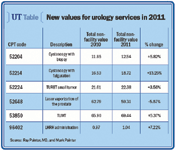Article
2011 final rule: Urology losses projected at 3%
The net effect of these changes for urology is a bump in the total values for many of the services that are provided.

The result in the 2011 final rule is a 30.8% drop in the conversion factor from $36.8729 to $25.5217, effective Jan. 1, 2011. At press time, the first move to reach this lower conversion factor was scheduled to take affect on Dec. 1, 2010, when the SGR dictates a conversion factor of $28.4061, representing a drop of 22.9% from the current conversion factor. Action by Congress and President Obama will once again be required to stop this massive drop in fees.

The final rule for 2011 included changes to budget neutrality that in turn affected the SGR formula calculation. Two major factors seem to have provided the biggest impact. First, drugs administered by physicians were removed from the SGR calculation. The removal of these drugs helped to raise the conversion factor for 2011.
The second change required that the index for inflation be changed from the consumer price index to the Medical Economic Index (MEI). The Centers for Medicare & Medicaid Services elected to apply the rebased MEI calculation to the practice expense and the malpractice expense values.

The slight bump in relative values, coupled with the budget neutrality adjustment, have Medicare projecting a 3% loss for urology in 2011 if the SGR cuts are once again delayed.
We are often asked if implementation of the SGR will be delayed. In our discussions, we both have admitted we are worried. In the past, discussion had centered on when, not if, the delay would be enacted. The politics now include a lame-duck session of Congress that was elected in part to undo health care reform and an upcoming group with a split message and a vow not to compromise or increase spending. Hold on to your hats and prepare for a bumpy cash flow at the least.
Many of you have read or heard about new self-referral requirements for services that require the use of equipment that is owned in whole or in part by the referring physician. These rules will go into effect with few changes from the proposed rule released in June 2010.
The interpretation we are being provided is that physicians who refer a patient for a service in which the physician has ownership will be required to notify patients of at least five treatment sites within a 25-mile radius where the patient can receive the same service. The final rule does not include a proposed rule to require the patient's signature confirming that he received this list of alternative choices.

New codes for percutaneous tibial nerve stimulation and radiofrequency micro-remodeling for incontinence have been added and valued (see sidebar above). Please check http://www.auacodingtoday.com/ for up-to-the-minute changes in fees for these and other services.
More than ever, urologists will have to be involved in the legislative process going forward. Contact your representatives and senators and give to UROPAC; we will need the help of Congress to avoid a deep cut in urology revenue.
Disclaimer: The information in this column is designed to be authoritative, and every effort has been made to ensure its accuracy at the time it was written. However, readers are encouraged to check with their individual carrier or private payers for updates and to confirm that this information conforms to their specific rules.
Urologist Ray Painter, MD, is president of Physician Reimbursement Systems, Inc., in Denver and is also publisher of Urology Coding and Reimbursement Sourcebook. Mark Painter is CEO of PRS Urology SC in Denver.





